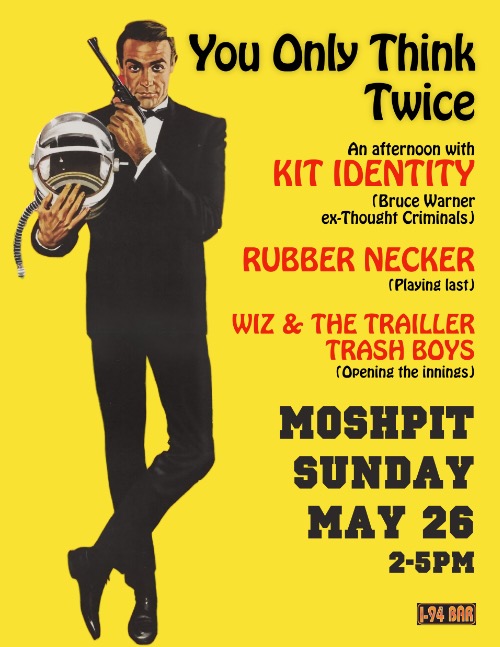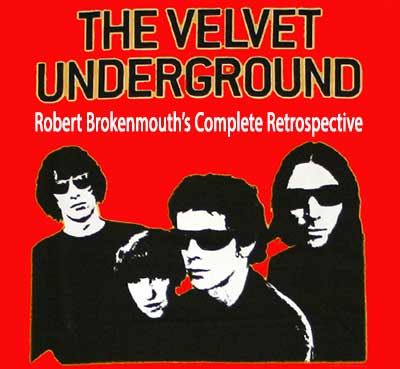 So on to "The Velvet Underground" (aka The Third LP). As Velvets fans know, this is the first LP with Doug Yule replacing John Cale.
So on to "The Velvet Underground" (aka The Third LP). As Velvets fans know, this is the first LP with Doug Yule replacing John Cale.
Disc One is the more usually recognised Val Valentin mix (the mix used for the 1980s reissue onwards); Disc Two is Reed’s slightly later ‘closet’ mix (the mix used for the original 1960s LP), or or Peel Slowly) and, for the first time in any broader sense, the Promotional Mono Mix (with the two shorter songs from the single).
The Val Valentin mix is the one I grew up with, as did several generations of later fans and musicians; so both mixes are obviously essential in the same box set, as is the rarely-heard promotional mono mix - it was several years became stereo became the norm, rather than mono. Curiously, the mono mix reduces the length of several songs, but adds a few bare seconds here and there.
In 2014, Discs Five and Six here were revelatory, ensuring purchase (one of the reasons I forked out). Most of these recordings were unreleased in 2014, but today, in the light of the "Matrix Tapes", surely they’re surplus to requirements.
I mean, there’s nothing wrong with these last two discs in themselves, or the order in which the songs appear here; these discs present the band doing two very different gigs; they’re at their most ferocious and their gentlest. Me, I rather enjoy the different tracking (to the "Matrix Tapes") which the Deluxe Box provides here, so I’ll be returning to these discs myself. But you shouldn’t need this box for that reason if you already have the "Matrix Tapes".
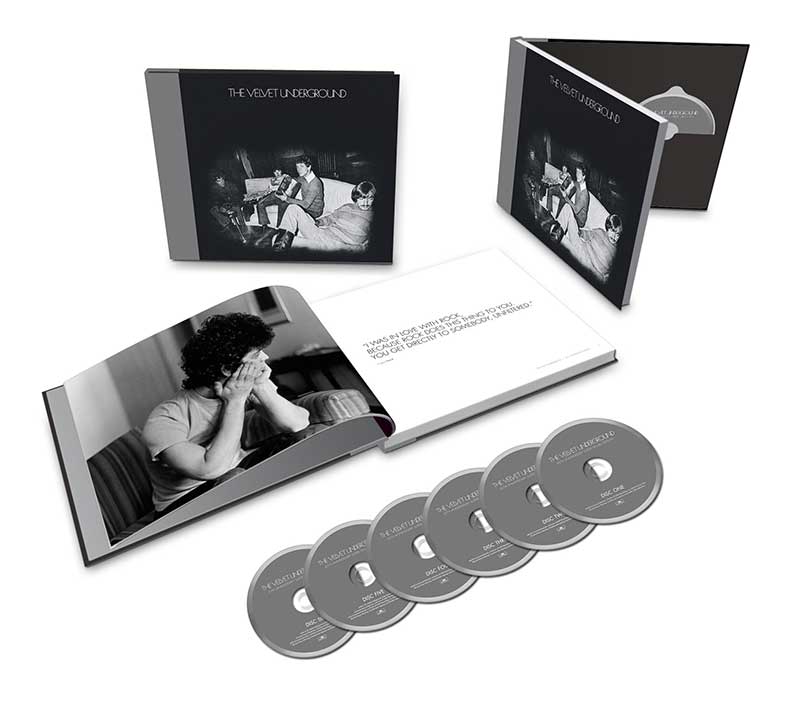
However. In some ways Disc Four is the kicker disc, the decider on whether or not you’ll shell out. However, all of these tracks turned up on the "VU "and "Another View" LPs, several more turned up at the end of "Peel Slowly"’s fourth disc. "Peel Slowly" also uses the previously unreleased Lou Reed ‘closet’ mix of the LP (pushing the vocals up or the music down: it apparently sounded to Sterling Morrison like it had been recorded in a closet), the fourteen songs on Disc Four are presented more or less as a complete extra double LP, and for me, that’s worth the price of admission to this Deluxe Box dreadnought - just for the context. Some of these tracks were remixed in 2014; others have been left with the ‘original 1969 mix’ - either way, as a package, this box is a superb snapshot of where the band were in 1969.
If, as I say, you don’t have most of this already (and you discount the value of the 2014 mixes).
(By way of indicating the intense hot-house of creativity going on in this band, there are three original - quite different - versions of songs which turned up later on "Loaded"; these songs aren’t repeated in that super deluxe box…)
So, I decided to visit familiar terrain first with the Val Valentin mix; Disc One.
So, the Velvets third (self-titled) LP finds Reed heading in what some have described as a different direction: but if you imagine their first LP without Cale and Nico… well, the similarities are more obvious. This third LP is overall quieter, more obviously melodic, exploring that other extreme Reed was interested in: it’s significant that after hearing Valentin’s more commercial, even-handed mix, he scuttled off to remix the LP with the focus on the lyrics. But it doesn’t work, not really. It’s the clarity of the Valentin mix which will remain the key mix for most of us.
Personally, I don’t think Reed was ever quite as evocative on this LP: particularly the LP’s closing track, "After Hours", sung by Mo Tucker. Now, although Reed certainly carries these songs, I’ve often wondered what it might have been like had Mo been asked to sing songs like "Candy Says", "Pale Blue Eyes", "Jesus", and even "I’m Set Free" and "That’s the Story of My Life"… Yeah, well. We could say that Reed was a tad megalomaniacal at the time, so that never would have happened, eh? And Mo was apparently terribly shy at this stage: if she’d sung half the LP, she wouldn’t have enjoyed singing them in public: it was quite a while before she sung "After Hours" live, and then it was by request (ie, not her preference).
Interesting, then that it is Cale’s ‘replacement’, Doug Yule, who sings the opening song, "Candy Says’" which marks the first formal appearance of one of Reed’s ‘So-and-So Says’ songs, and it is, as many of Reed’s songs are, rather deceptive - if you listen to the lyrics with half your brain working. Without knowing the details of the song’s subject - which would have been most of the Velvets’ audience - we’re plunged into the intimate life of a girl called Candy: who is, of course, not just anygirl, but anyone. Many of Reed’s songs - particularly from this period, I think - are about ‘everyman’, a universal ‘anyone’.
"What Goes On" is next, kicking down the doors after the introspective beauty of "Candy Says". Until the release of the live double LP in 1974, the 1969 closet mix of "What Goes On" was a cracking, loping song with one of those strident, fabulous guitar breaks which nearly takes the top of your head off. Their live versions of this one are faster and positively melt the ether. Neither here nor there. Shame even the longest version of this song still fades out. But all the tracks have to fit onto a side.
"Some Kinda Love" has a similar, low-down groovy lope and again the band are a bit faster live. Listening after the "Matrix Tapes" has rather spoiled me, I’m afraid. However, the vocals are nice and clean; you can hear Lou enjoying the playful nature of this lyric, even before the rather startling; ‘put jelly on your shoulder/ do what you feel most’.
"Pale Blue Eyes" is one of Lou’s most touching songs; there are so many wonderful cover versions. But this version is the template. If you’ve not heard it…
The last song, "Jesus", is probably the most head-swivelling song. The opening lyric, ‘Jesus/ Help me find my proper place’, and what follows is performed so straight, it’s a wonder more people haven’t commented on it. For all those appalling religious LPs which turn up on sites like ‘WTF Album Covers’ (or whatever), I defy them to produce a more heart-felt, sincere song dedicated to Christianity. It’s utterly beautiful, and makes us wonder, particularly after all those songs about S&M, trans, sex and smack on the first two LPs, not just whether this is some kind of sick joke or exercise in heresy, but what the hell was going through Reed’s mind? The quiet, pretty simplicity of "Jesus" is hugely effective… Fricke doesn’t seem to nail the whys of this one; ‘falling out of the sky’ and forming naturally … that’s fine as far as the composition goes. But the decision to put it on the lp..?
Anyway. That’s the end of Side A, and it’s a hell of a journey.
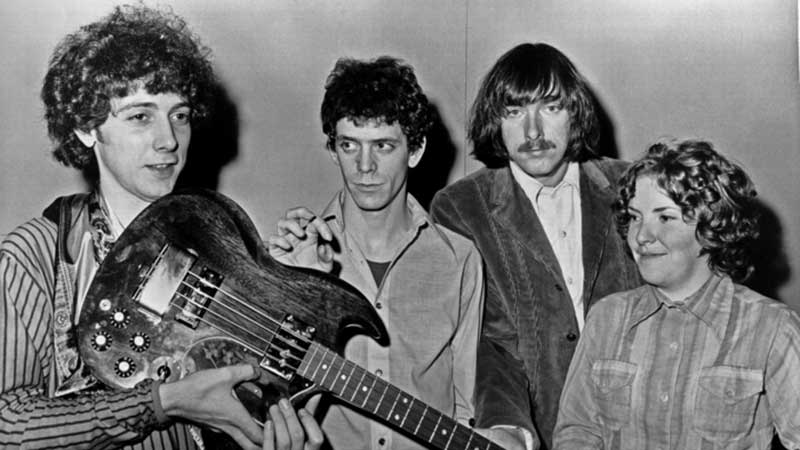 Doug Yule (left) and the Velvets.
Doug Yule (left) and the Velvets.
Side B begins with "Beginning to See the Light", apparently another mixed-message song, but really, it’s the entire band having a blast as a band. It’s almost as if Lou started a lyric, ‘Here we go again/ I thought that you were my friend’ … and then realised he was having so much fun - ‘there are problems in these times/ but hooo! none of them are mine!’. This another of those thundering trucks that they did so well live: we only get a hint, really, of what this song is capable of; again, the Matrix Tapes have spoiled me, their live versions of this cook.
However, in context with after Side A, it snaps you up and out of your chair, dancing so hard the needle jumps and you have to buy another copy. "Beginning to See the Light" is one of those rare marvels, a song which touches on something profound, beautiful, but which harbours delight and joy of life which is positively idiotic at times (Lou’s occasional yelping, if you need another example). In the best r’n’r, stupidity rubs shoulders with truth, love and laughter. One of the most perfect r’n’r songs…?
"I’m Set Free" changes the pace back again; the achingly beautiful quasi-religious nature of this one reaches right into us, but it’s actually the most critical heresy you could imagine.
And now I'm set free
I'm set free
I'm set free to find a new illusion
I've been blinded but
You I can see
What in the world has happened to me
The prince of stories who walk right by me
Apart from anything else, even taking the song at face value, we’re looking at a song for the ages, another ‘everyman’ song. The structure, the guitar work throughout have, I think, proved as influential as, say, "Pale Blue Eyes" has. Yet, "I’m Set Free" has so much more complexity - and that, of course, is part of this band’s genius: you can hear the simplicity but the complexity builds up in layers and threads.
"That’s the Story of My Life" has a joky, folky tang to it, but again, with an aching sweetness carrying the song along we’re somewhat beguiled. Actually, in context, however enjoyable this one is, it’s the weakest song so far (despite Reed’s broken, fractured vocal). And this, I think is where the cracks appear in the LP as a whole.
When I first heard "The Murder Mystery", it was more intriguing than daunting. These days I think that listeners aren’t as patient with a recording. If it doesn’t please you instantly, we can move on to something else. It seems that, for most people, "The Murder Mystery" is too much of a stumbling block, people find it to be out of place. But it’s a damn sight more entertaining than "The Gift".
Personally, I like it, and it fits. However: when making your mixtapes, I reckon this one will be on the challenging, rarely-listened tape. The liner notes say that the vocals are by Morrison and Reed - I have to say that it sounds more like Morrison and Tucker, quite frankly. Either way, even though it’s a beguiling, very funny track, with tumbling out like Mo’s drums, you have to really concentrate on what’s going on to get it. Music all around and each vocal in a different speaker… and then that lengthy rather bonkers ending. ‘Dumb and ready pig-meat’?
"After Hours", the last song, is probably my favourite on the LP, and links up with many elements already set up (with the exception of the two preceding tracks). Like several of Lou’s songs here, there’s more than a duality of meaning here: Mo has always said that "After Hours" is about the end of a long night partying, feeling washed-out and so on. But equally, it could be someone contemplating suicide. More than easily.
The Velvets’ third lp is their most commercial to date (including "The Murder Mystery"). Even so, everyone who bought their first and second LPs, had clearly found sufficient cause not to investigate further: their third bizarre LP cover in a row can’t have helped sales.
That said, the Velvets’ third LP has proved equally influential: for example, the Jesus and Mary Chain certainly owe this lp (not just the first and second) a deep and powerful debt. (The JMC also owe much to the Birthday Party, especially Nick and Rowland, but that’s another book).
One thing which puzzles me is that the compilers decided not to add many tracks at the end of the LP proper on the first three discs; the LP goes for around 45 minutes, so this does rather seem like an odd omission. Disc Two only has an alternate ‘closet mix’ of "Beginning to See the Light", for example, and Disc Three gives us two (shorter) mono single mixes. Perhaps they were going for a clean comparison between the variant versions? Perhaps there were other tracks considered but rejected…
So, they albums are complete, but makes me wonder about all that space left… Quite apart from anything else, I wonder if they considered two different mixes of "The Murder Mystery" (as they did with "The Gift"), each with only one vocal, just for clarity’s sake? Hell, it would sound interesting without the vocals, as well.
So what’s the difference between this mix and Reed’s ‘closet mix’..?
Well, obviously, all the vocals come up a little more, and you’re zeroing in on the lyrics much more. I mean, it’s a taste thing, which version one prefers… however, I do think Lou put the vox a bit too far up in his mix; I can understand him wanting a bit more boost to the vocals, but I think he’s compromised some of the musical beauty - the doo-wops in "Candy Says", for example, deserve to be up where they are in the closet mix, but not the main vocal.
For rockers like "What Goes On" and "Beginning to See the Light", no, sorry Lou… not the right decision. Hell, they’re great songs. Maybe tweak the vox up a tad across the board from Val’s mix. But not quite this much; they verge too much on dominating the huge power of the band, and the songs themselves. Again, "Pale Blue Eyes" is a gorgeous song, but the vocal is a little too front and centre. It’s only a couple of notches, doubtless, but what a difference it all makes.
"I’m Set Free","Jesus" and "After Hours" are the only songs where Reed’s mix seems to work properly, as Val’s mix always seemed to have the vocals a tad too low; you want to lean forward to listen to a vocalist, but not strain…
Now, from a more critical point of view, I’d think Val (who was the band’s engineer as well) didn’t quite capture the Velvets’ big bastard sound clearly enough. On the other hand, he did damn well to get so much on what, four tracks? when the recording methods in the day were almost specifically designed to weed out anything like harmonious drones or feedback (or ‘leakage’ as it was called). Reed also reduces the length of songs like "What Goes On" and "Some Kinda Love", tho’ a couple of songs find a few seconds extra.
As to the mono mix (the third CD); well by now you’ll have twigged I rather like mono; the immediacy is … yeah, so I’m a bit strange. Also, the mono mix seems a lot rougher, more gritty for some reason. "The Murder Mystery" works rather differently in mono, and as I say, several tracks have been shortened on both the closet and mono mixes. So out of all these deluxe boxes, I’m most tempted to use these different versions of the songs do an alternate third LP. Here:
"Candy Says" (mono)
"What Goes On" (Val)
"Some Kinda Love" (Val)
"Pale Blue Eyes" (mono)
"Jesus" (closet/ mono)
"Beginning to See the Light" (mono)
"I’m Set Free" (closet/ mono)
"That’s The Story of My Life" (mono)
"The Murder Mystery" (mono/ Val)
"After Hours" (closet/ mono)
But that’s me. And it will take the aficionado several happy hours of listening and comparing to decide one way or another.
Disc Four:
So. 11 sessions, some of which have turned up on bootlegs in much fuzzier form, and 3 other sessions, with earlier versions of songs which were eventually rerecorded for "Loaded". Is Disc Four a decider for you?
"Foggy Notion", "One of These Days", "Lisa Says", "I’m Sticking with You", "Andy’s Chest", "Coney Island Steeplechase", "Ocean", "I Can’t Stand It", "She’s My Best Friend", "We’re Gonna Have a Real Good Time Together", "I’m Gonna Move Right In" comprise the "VU" and "Another View" LPs from ’85 and ‘86; what makes these different here is a better, clearer 2014 mix.
The early versions of "Ferryboat Bill", "Rock and Roll" and "Ride Into The Sun" (also on "Another View") are sufficiently different for us to wonder if any more of "Loaded" were recorded at this time.
So, again, if we discount the 2014 mix as not being essential, if you have "Peel Slowly", and the original Val mix of the LP, plus the 1985 and 1986 "VU" LPs or even the later CDs, and the "Matrix Tapes", then you’re not going to need this Deluxe Box unless you really really want it and, frankly, you like the idea of these songs being placed in a different context, as Disc Four presents an alternate double LP instead of a few extras at the end or beginning of another LP, and Disc Five and Six present two differently ordered VU gigs.
And I suppose that’s all part of it, really; one of the reasons these Deluxe Fistful of Extras boxes work so well is that you’re presented with a series of possibilities… and it all takes you closer, into the band itself as you try to crack the code. This level of involvement is the next best thing to seeing the band live over and over.
Around about this time, 1969, more and more fans were taping the band’s gigs. One of these was Bob Quine.
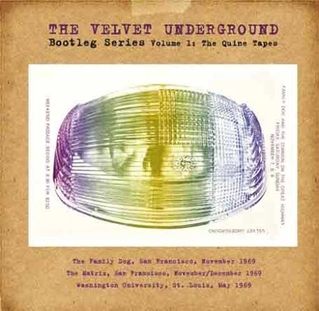
"The Velvet Underground Bootleg Tapes Volume One: The Quine Tapes" (2001)
Does anyone still believe that Richard Hell’s voice was the only major attention-getter on the first Voidoids lp? No, it was Bob Quine’s slicing, piercing, antisocial guitar; the bizarre angularity cut across the songs, making Hell’s lyrics seem far more than they (whisper it) … actually are.
Writing in 2001, Quine writes about how he came to record the Velvets, sounding like a fanboy with his first crush, and not like the hugely successful and influential guitar maestro he was, nor a fucking dry as dust journo or academic. Enthusiasm counts, it’s what makes us creative…
But this box set is a triumph surrounded by horror.
‘After they left San Francisco, I spent months constantly listening to the cassettes I’d made. But the technology then was relatively primitive - it wasn’t uncommon for cassettes to jam in the machine and get ‘eaten’.’
Alright, if you’ve read this far you’re either daft or a Velvets fan, or both, and right now if you haven’t read this before you’re clutching your heart, sitting down and losing feeling down your left side.
Call an ambulance.
Sorry, put this review down first. Sorry.
Now, you’re back and waiting to read the rest. I hope you have some anaesthetic handy, as Quine continues…
‘I borrowed a 7-inch reel-to-reel Sony machine and copied about four hours of what I considered to be the best performances [of individual songs]. I’m glad I did it because the original cassettes became quite worn, damaged and ultimately misplaced.’
We’ll leave it there, you can read the liner notes yourself. When you recover from the knowledge that Quine recorded the Velvets’ entire Matrix stint - that is, their gigs over an entire month, plus three gigs at the Family Dog and one at Washington University - you just have to hope that Quine selected his songs wisely. That’s nearly 20 full gigs - not just the usual 45 minutes to an hour sort of set per gig, either. We’re talking something like two long sets per evening. Recordings of a band who (I may have mentioned) liked to vary each song every time they did it. And seemed to enjoy doing it.
As you’ll notice, Quine’s collection are not the clear clean sparkly stuff of the "Matrix Tapes" (according to that box, those four full CDs were recorded at The Matrix on 26 and 27 November 1969). No, these are rather more prosaic, similar to many of the bootlegs which have cropped up over the years. These ancient, primitive recordings have been digitally compiled and remastered, too…
Just to make life interesting, Quine’s box refers us to one song, his recording of ‘Rock’n’Roll’ on the 25th, as being the same version (but a different recording, of course) as that which turned up on the ‘Live 1969’ double LP in 1974 - that is, from "The Matrix Tapes". Clearly, someone has their dates out of whack. Anyway, "The Quine Tapes" is a natural appendix to both "The Matrix Tapes and "The Velvet Underground" (third LP) box as they’re all of a period.
Disc One is 11 songs culled from three nights at The Family Dog, 7-9 November; Disc Two is 5 songs from The Matrix from late November to early December; and Disco Three is also all at The Matrix; 6 songs from late November and one from early November.
There is another entertaining discrepancy: Disc Two starts with a song apparently from the 27th November which doesn’t turn up on the "Matrix Tapes" at all ("Follow the Leader").
All that nonsense aside, by now, if you’ve got any of the Deluxe boxes, you’re reaching for the credit card. Yes, they’re a bit rough and fuzzy. But it really doesn’t matter. You’re listening to a band effortlessly running through a familiar series of songs and taking them somewhere different every time. Also… these tapes are a fine reminder of what Velvets fans had to put up with for years: wuzzy fuzzy recordings which we had to listen to carefully, as if we concentrated too hard on it all, the music would break up… because the songs sounded like that, brittle and broken and beautiful and harsh and gentle and… Look.
The thing about the Velvets is that you always want more. It’s that simple. Some of us feel that way about the Stooges, too. I’m sure there are people who have to have everything ever recorded by New Order, too … but that, surely, is simply being completist. No, the folk who want everything by the Velvets and the Stooges are folk who listen with headphones at night, soaking up every little nugget. You are there, right there, in this poky, smoky club with a few mates, most of you dressed in your daggies, and this huge beast comes out at you, measured, smart, challenging and louche.
So when Fricke remarks in his "Matrix Tapes" notes (yes, it’s Fricke again) that ‘the band was… extensively documented in concert … typically by fans and most thoroughly in 1969 at clubs and dancehalls like the Boston Tea Party, Cleveland’s La Cave [and] the End of Cole Avenue in Dallas’ you rather feel like strangling him.
Why? Well, let’s put it this way. I still have a thirst for the Velvets. Because I love listening to how their live songs dance around an axle, around a centrepin, even the most cursory inspiration has their songs leaping around. We’re not talking strict structure here. And because of that, their recorded inspiration will remain with everyone who gets this band first go-round.
I mean, even as an appendix to Quine’s illustrious career, the "Quine Tapes" are a career highlight.
So, where to now? Straight to the band’s next LP? Well. That would make sense.
But after all that looseness and freedom, that downbeat humour… I begin to wonder at the absence of Cale. Reed clearly couldn’t cope with what I suspect he felt was the creative power struggle. Sterling and Maureen didn’t really want Cale to go. It wouldn’t be the unit. Wouldn’t have the same magic.
Reed, however, knew he could create a different magic with the rearranged personnel, which of course he did.
So I start thinking … just what on earth was it Cale brought to the band? What were his interests?
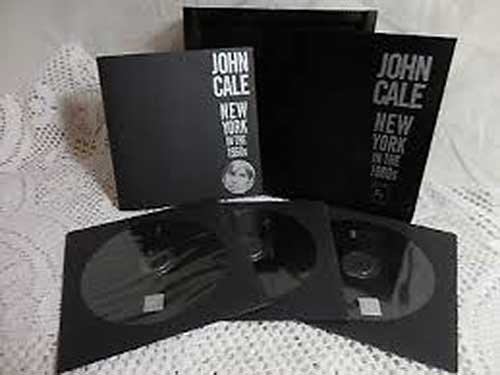
John Cale: "New York in the 1960s" (2006, Table of the Elements)
(also known as the "Inside The Dream Syndicate" trilogy)
Initially issued as individual CDs, the box was released in Europe. This kind of compilation of rare oddities creates a little gem of a box - it was snapped up so fast it made downloads and bootlegs inevitable.
Disc One: "Sun Blindness Music"
The title track, "Sun Blindness Music", was recorded on 28th October 1967, after "White Light/ White Heat" and Nico’s "Chelsea Girl" and it’s a must-have. Basically, it’s just Cale on a Vox Continental Organ, riffing and droning like a man possessed, layering waves of feedback and drone up and down your speakers, giving the keys a thorough workout from subtle to ball-crushing.
This is truly the ancient dark heart of the Velvets. Think of all the most brutal of Reed’s guitar howls, and … well. Here it is, but better in some ways, without vocals … it’s just full-on, intense. No wonder there was something of a noise struggle in this band. There’s also sufficient variation in the music that you can’t really stop listening and tune out. Which means it’s perfect for playing damned loud as you’re driving down the highway, breaking the speed limit and zipping past the coaches and trucks. Not that I’d recommend you do anything like that. I mean, what are the odds, in the conservative 1960s, with pop and flower power and cutesy hippies and burgeoning radical chic and all that, that two such lovers of extreme music would find each other and form a band?
Cale lasted another full year after this recording with the Velvets: "Sun Blindness Music" might also indicate more clearly one aspect of Cale which Reed would have found difficult - Cale, like Reed, was as Top Cat as they get, effortlessly so.
Just like Reed.
Heavy, man.
It’s damned hard to make any musical piece, with just one instrument, hold your attention in this modern world of short attention spans and jittery coffee-addled thickwits. But here’s Cale on electric guitar, and "Summer Heat" is brutal. A shade over 11 minutes this masterpiece was recorded August 1965. Essentially he’s working over a riff, but honestly, you could take this track and add a vocal to it today, it’s that modern. I love the repetition, build-up and then the thing shifts and changes; he also stops dead sometimes, letting the feedback and decay float on… before returning to the assault. In that sense it actually reminds me a little of "Metal Machine Music"’s ‘always different, always the same’ technique. And, The Fall, and a hell of a lot of modern rock bands. Boris would love this one. So would Wire. The ending is surprising, sounds rather like the tape machine fell off the amp and went clunk.
The last track is "The Second Fortress", nearly eleven minutes recorded ‘late 67/ early 68’, which shows how the best of us can’t always write down the date we made something. Cale is credited, even more extraordinarily, as playing ‘electronic sounds’ … no idea what he’s actually using (he’s probably forgotten). It might be an early synth. Or a rewired organ. Or feedback. Christ knows. But it’s wonderful, soothing … it ripples and shoves and rolls like a series of tides. Given the level of technology available at the time, the result is nothing short of inspiring.
What an incredible CD.
The second, six-track, disc is "Dream Interpretation: Inside The Dream Syndicate Vol II" is the youngest track over the entire NY in the 60s set, which of course has huge ‘influence’ connotations for any Velvets nutjob. The first track, "Dream Interpretation", where we spend over twenty minutes with Tony Conrad on violin, and Cale on viola, and they growl, drone and moan like the kind of feedback Reed could only dream of. Recorded five or six months after Cale has been dismissed from the Velvets (Lou was under pressure to make the Velvets’ LPs more commercial, while Cale apparently wanted to record the next LP with the amps under water), and seven since Cale’s first major LP production credit (The Stooges). If I told you this was the missing link between the Cale-era Velvets and The Stooges, would you believe me?
The second track, "Ex-Cathedra" is also the second of Cale on the Vox Continental Organ (recorded on that that wonderfully specific date ‘late 67 or early ’68). This track is a mere five minutes, the notes and tones ricocheting around hypnotically… actually, it reminds me a lot of Steve Reich’s compositions until it, too, seems to end by falling off a table.
"(Untitled) for Piano" is John on piano … and god alone knows what he’s doing to it, but he’s clearly banging on the wood, and also sounds like he’s inside the ruddy thing. It’s miked up, so it’s somewhere between battleships being ground up for razor blades and a sonic creeping wolf thing. On this recording alone, the man should’ve been swept up by film studios to do soundtracks. Recorded ‘early-mid 1960s’… good god. Hearing (Untitled) makes you wonder what the Velvets actually might have been. Faaaarrrkkk.
"Carousel’"(‘late 67 or early 68’) is Cale playing ‘electronic sounds’ - which sounds like someone’s bones being grated. Genuinely frightening. But, like all the pieces … imbued with a vast beauty.
The wonder of these pieces so far is that they are so clever, involving, and evocative. They’re filled with pace, drama, verve and panache. Once, of course, you get past the ‘where’s the guitar and where’s the vocal’ stuff …
No, I’m not going to go on about this. Enough. There’s the rest of this disc, and another, including music with Tony Conrad (on one song playing ‘thunder machine’), Angus MacLise, Cale on a Wollensak, and featuring (I shit you not) the NY Fire Dept on vocal … but all you really need to know is what I’ve told you already.
"New York in the Sixties" deserves a clearer link with The Velvet Underground Super Huge box set series - apart from anything else, any one of these discs would be a better fit in, say, the three-disc "White Light/White Heat" Super Deluxe Box; and certainly would not have been out of place in the …"& Nico" Super Deluxe etc. "Summer Heat" (to choose just one example) would not have been out of place on the third lp Super Box either, just as comparison; the thing is, the entirety of NY 60s deserves a place alongside the Velvets. Essential, as far as I’m concerned.
If you’re more of a fan of the third LP, the "Matrix" and "Loaded" periods, tho, you probably won’t find the price of admission.
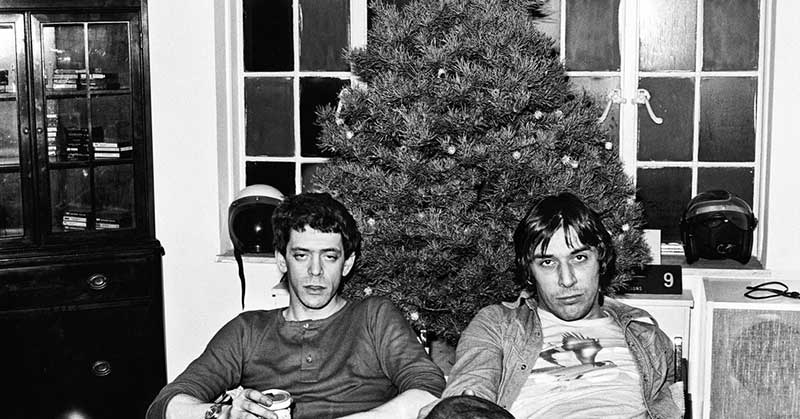 The Lou Reed and John Cale Glee Club AGM
The Lou Reed and John Cale Glee Club AGM
So. Which sets do I recommend?
"The Matrix Tapes" is, I think, essential. It’s also a wonderful, intimate introduction to a band filled with extremes of all sorts.
"Peel Slowly and See" I think, next, for the complete introduction. Because it’s a bit of a grab-bag you’ll probably want to do a bit of mix-taping.
And, if you enjoyed "The Velvet Underground and Nico" then you really need the Super Deluxe Boxes if you want to go a bit further.
The Super Deluxe box of "White Light/ White Heat" I can’t walk away from. "The Velvet Underground" Super Behemoth as well, the live stuff, the out-takes, even the order of the songs already issued, all demand purchase. You may disagree and not plump for the Super Deluxe third lp box…
"Re-Loaded" vs "Fully Loaded" - well, you’ll probably plump for the two disc "Fully Loaded" set here. Honestly, it’s a good LP on its own, but when nailed up against 1) the other three LPs and 2) say Disc Four of "The Velvet Underground", or even one disc of "The Complete Matrix Tapes" … nah, it’s an appendix at best. Sorry, Lou.
"The Velvet Underground Bootleg Tapes Volume One: Bob Quine" (2001) … call it an essential appendix to "The Complete Matrix Tapes", if you like, but seriously, this is where the NY punk got that angular guitar brutality from: via Quine. Personally I think the "Matrix Tapes" and the Quine boxes are far more essential than "Loaded" in any form, but that’s probably me.
And I’ve just finished telling you what I think about "John Cale: New York in the 1960s" (2006). If the raucous nature of the Velvets does not appeal…
… return to the top of this review and start again.
Now, surely that’s it for the Velvets Super Deluxe treatments? Surely there could be no more…?
Well, there are a few obvious starting points.
The first would be a (say) three disc set of alternate versions, unreleased, live and other mixes of the band’s entire career culled from the box sets. This in itself would relieve some of the financial pressure fans feel in the face of these Super Leviathan Luxury Liner jobs, often daunting on the pocket. Certainly there would be sufficient demand to warrant such a collection, because not every Velvets fan will have shelled out for the Deluxes…
The second, which I’m sure will be taken up with emphasis by Reed fans, is Lou Reed. Now, there’s a new remastered 17-disc box set of almost all his studio LPs, the man’s last work, apparently. But don’t some of these records merit a Leviathan release? I mean, it’s almost common these days. How many of Reed’s LPs turned out to be hugely significant in the long run? "Transformer" is obvious, but "Berlin", and "The Bells" … and, as Carlton Sandercock at Easy Action has demonstrated, there are plenty of decent live Lou Reed recordings.
The VU run by Doug Yule after Lou left has always been dismissed (possibly unfairly as I’ve never troubled myself to hear them); while that outfit merited a four disc live set in 2001 (by Captain Trip), "Final V.U., 1971-1973", I’ve never seen it, much less heard it, nor the studio lp Squeeze. Related to this is the gig with Cale, Lou and Nico at Paris’ Bataclan in 1972. Surely that should finally see a proper release. Bob Short, a lifelong Velvets fan, actually went to the trouble and claims it’s not far removed from the "Loaded"-era. Which means, as far as I’m concerned, if I see it cheap I’ll have it but probably never play it. Or at least not much.
John Cale is someone whose solo career, I feel, has been quite unfairly kicked into a corner. I’ve seen him live twice, and love many of his solo records. I’d like to see many of them given - at the very least - either a box set treatment of the lot, or a two or three disc set treatment each. Yes, I know 1982’s "Music for a New Society" was reworked as "M-FANS" in 2016, but that’s scratching the surface
However, there’s still a lot of unfinished Velvets business; the live tapes which are still out there should definitely be gathered, tidied and released; it’s not as if there’s no demand. There’s that amazing gig at the Boston Tea Party on March 15, 1969 where two individuals were recording, one machine captured the band entire, the other had their mic next to Lou’s amp, and … yeah, you know where I’m going with this. Numerous gigs were recorded at Cleveland’s La Cave, Boston’s Tea Party and plenty of others. Bootleggers have issued them on cassette, or partially on LPs (the Australian 1983 bootleg, "Live ’68", is nothing short of fabulous); there are numerous Velvets compilation LPs which of course leave us wanting more; the first three tracks on (Australian bootleg, and the second ever Velvets bootleg) "The Velvet Underground Etc" (1979) are of Lou Reed’s early 196ts ‘bands’ The Beachnuts and The Primitives, which as far as I know haven’t yet turned up legitimately.
And of course, if we’re still digging into the roots of the band… I suspect there’s more of Cale’s work before the Velvets; the works on "Sun Blindness Music" would seem to indicate that they’ve been drawn from several tapes. Which makes us wonder, are there any Lou Reed/ Cale noise compositions out there, as Reed implies when he talks about "Metal Machine Music"?
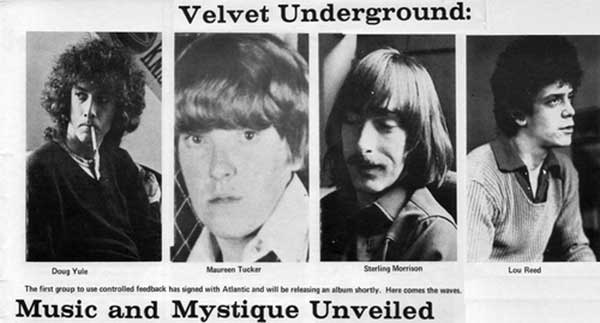
Apart from anything else, the 1965 rehearsal tape issued as an extra cd on "Peel Slowly" is incomplete; the notes in "Super Deluxe Velvet Underground and Nico" make it clear that quite a few recordings are still unreleased. So, you could even moot a Super Deluxe ‘roots of the Velvets’; the Primitives (I wonder if anyone was odd enough to record that band’s gigs?); Cale’s work with La Monte Young, Reed’s for Pickwick… yes, some of it has turned up… but hell, bands like Einsturzende Neubauten and Wire consistently record their gigs, and sell them. EN have issued a memory stick with every gig performed (up to the point of purchase, natch).
The liner notes for the Super Monster Chicken Pieces Boxes also indicate that there’s still more 1966 rehearsal tapes which have yet to see the light of day (with and without Nico); and several live gigs recorded on decent recording equipment; hell, the Aspen flexi track "Loop" has never seen the official light of day (but it’s on "The Velvet Underground Etc"). C’mon, there’s nothing wrong with a Warhol period Velvets box without repeating anything released thus far. Hell, you could justify a Super Deluxe behemoth live box focusing on the period around each album. Stranger things have happened.
And, just to annoy every Velvets fan (and get them salivating), I’m going to refer again to the booklet which came with "Peel Slowly". David Fricke’s essay there refers to different takes of "The Velvet Underground and Nico"… now, there certainly seem to be a fair number of alternate takes and mixes on the Super Deluxe, but one wonders if there are any more..? And one wonders about the second and third LPs as well… no, the notes don’t make this clear.
Lastly, the Velvets reunion tour of 1993 was filmed at least once, and I suspect most gigs were recorded, and I believe some rehearsals, and some new songs were attempted: "Coyote" featured on the double live set, "Live 1993"... Surely this deserves another issue, but certainly a VU Reunion DNA-Based Gigantic Woolly Mammoth Box Set should be in the works…
If you love the band as much as I do, hoping for any (never mind all) of the above is a no-brainer.
If you think this is obsessive… well. That’s ok. The Super Deluxe editions, as well as the "Peel Slowly" set, have all sold very well, thank you. And those bootlegs keep selling, too.
If you decided to listen along with Robert while you’ve been poring over this, and found you disliked the VU intensely, well, that’s ok. If you found you just don’t get it at all, that’s fine too. If you think the VU weren’t anywhere near as influential or important as I say they are, well, I’ll leave you to your Lionel Ritchie, Boz Skaggs, Air Supply, and Willie Nelson CDs. Or, if you’re younger, Nickelback.
But if you did in fact have no response whatsoever, then I can only suggest that you have a serious illness and need to consult a doctor rather swiftly, as your ability to respond to stimuli of even the most mundane kind has become severely impaired. Please never describe yourself as someone who loves rock’n’roll in my presence. Possibly Jon English is the muso for you, or perhaps you hold a torch for Sting. Is [insert name of loser country here]’s Got Talent more your thing? Coldplay? Stryper? or … Limp Bizkit?
If you’ve listened to the Velvets and found you love them … form your own band.
You’re not alone.
Where do you get all this shit? Start here.
THE END


